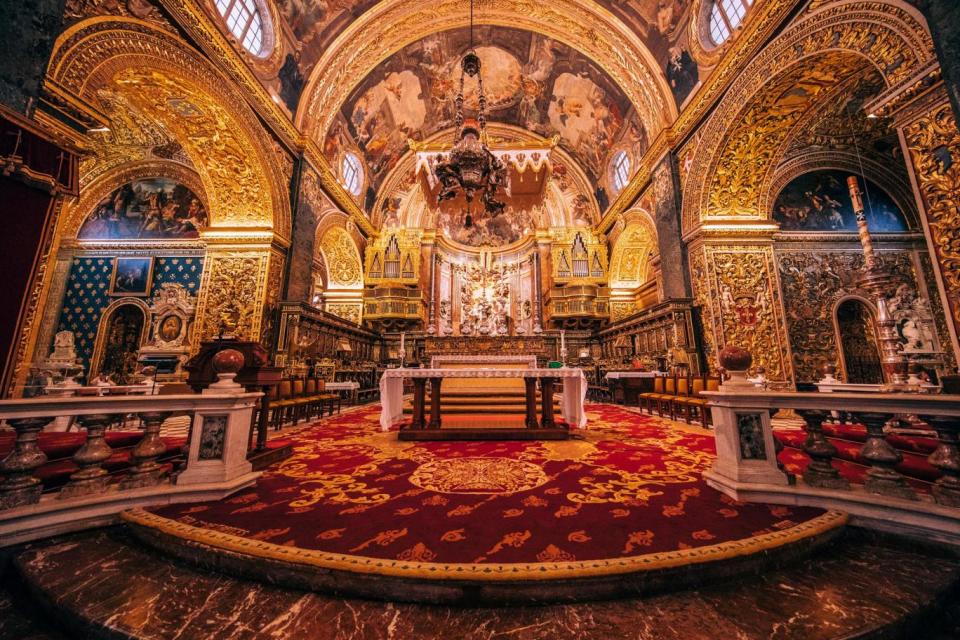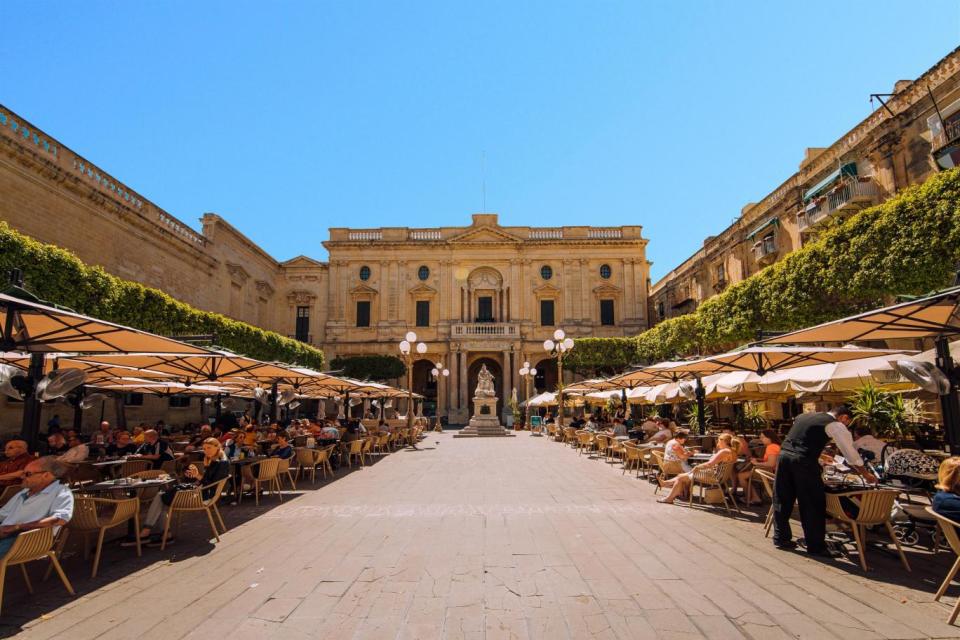10 reasons to visit Valletta: this year’s European City of Culture

With its grand palaces, all year-round sunny climate and spectacular harbour views, Malta's Valletta - this year’s European City of Culture - has much to offer visitors.
From feasting on the freshest of seafood, to marvelling at Girolamo Cassar’s masterpiece, St John’s Cathedral, or exploring the three fortified cities of Birgu, Senglea and Cospicua, a long weekend in the Maltese city will not disappoint.
If you are contemplating a visit, here are ten reasons to book that flight...
1. Knights of Malta
The military branch of this ancient Catholic order, originally founded in Jerusalem during the time of the Crusades, came to Malta in the 16th century and retained a pivotal role in protecting the island, notably seeing off the Ottoman Turks in 1565.
Following the Great Siege, the Knights, who came from all over Europe, settled on the island permanently and, under the aegis of Jean de Valette, created a new fortified capital city: Valletta.
The next two centuries - known as the Golden Age - saw the creation of much of the art and architecture that makes Valletta so compelling today, from the extraordinary bastion fortifications to the churches and palaces, all built in honey-coloured limestone rock.
In 1798, Malta was invaded by the French and became a French-occupied territory, until 1800 when it became a British protectorate, which it remained until Maltese independence in 1964. The Knights of Malta continued to have a significant presence throughout, albeit with dwindling powers, as they do to this day.
2. Eating out
Thanks to its mixed Mediterranean heritage, Maltese cooking fuses Italian, Greek and Arab, plus something imperceptibly all its own. The best dishes to try almost anywhere are the fresh seafood, fish and local sheep’s cheeses.
For a light bite and a glass of something special, try Cru on St Lucia Street, one of a new breed of hipster wine bars springing up in this formerly dingy area.
Best basement bistros with cosy interiors and delicious food include Rampila, Legligin and Guze but these need to be booked ahead.
For a classy supper, try Noni, and for spectacular views of the Grand Harbour, the wonderfully breezy Harbour Club restaurant is your best bet. Locally brewed Cisk pilsner can be enjoyed, ice cold, anywhere.
3. Caravaggio in Malta
The famously fiery-tempered Italian artist came to Malta from Naples in 1607, while on the run after killing a man in Rome. He was ordained as a Knight of St John and painted the Beheading of St John the Baptist for the Order, which today sits in the Oratory of St John’s Cathedral. It’s an extraordinary painting, dark, violent and dramatic.

Opposite is his St Jerome Writing, no less dramatic with its flowing blood red robes and sharp contrasts of light and shade, yet this picture is also a tender, intimate portrait of ageing.
4. Palaces
Walk almost anywhere in the city, eyes raised upwards and you’ll see a palace. A typical example is the 16th century Casa Rocca Piccola, which is pleasantly run down and still lived in by the ninth Marquis de Piro and his family.
Among its collections is a display case of pope’s slippers, lace panels, chess pieces and silver ex-voto offerings, as well as countless paintings and ceramics.
For armour and weaponry buffs, the Grand Master’s Palace is another must. It remained the official residence of all the Grand Masters and later, the Governor’s Palace during the British period.
Today, while it is the seat of the Office of the President, it also houses a fine display of some of the 5,000 suits of 16th - 18th century armour, which are all that remain of the original horde, while murals in the State rooms tell the story of the Great Siege in 1565 with brio. The inner Alfred’s Courtyard is especially peaceful.
5. Game of Thrones
Eagle-eyed aficionados will instantly recognise the setting for some of the key scenes in Game of Thrones when they visit Mdina, the fortified city in the North of the island, half an hour’s drive from Valletta, and site of the island's capital until the 16th century.
Founded by Phoenician settlers in the 8th century BC and known as the Silent City, it still feels wonderfully ancient, thanks to a near absence of shops and its beautifully preserved architecture. Behind the imposing stone walls – some seemingly impenetrable - are palaces and convents with hidden courtyards and secret gardens, including the luxurious Xara Palace Hotel beloved by celebrities and the Hollywood actors who come to shoot on location here.
6. Culture and Festivals
This year sees Valletta taking front stage as the European City of Culture 2018. Over 1,000 events are being put on throughout the year which means you are bound to find something whenever you go.
For the full programme see valletta2018.org. This is in addition to the regular festivals such as the Malta Jazz Festival (18-21 July), Notte Bianca (6 October) and the Three Palaces Festival (3 – 12 November); festivalsmalta.com.
7. Confectionary
Nut-studded nougat, soft almond cakes and honey and date paste-filled pastry rings are just some of the delicacies you must try while in Valletta. Better still bring some home in your suitcase too.

The legendary Caffe Cordina on Republic Square has a mouth-watering selection – eat al fresco or sit inside this beautiful mid-19th century café, watching the bustling waiters. You can also find a good selection of sweet things at the restored Victorian covered market, with its lovely iron railings, Is Suq Tal-Belt or for the best value, visit Beehive Honey Nougat. Although the shop is off the beaten track outside Valletta, at 14,Triq iż-Żebbug, Żebbug, if you’re taking a taxi to the airport, take the 20 minute detour on your way.
8. Churches
No visit to Valletta is complete without seeing Girolamo Cassar’s masterpiece, St John’s Cathedral, dedicated to Saint John the Baptist and commissioned by the Order of St. John between 1572 and 1577.
With its high Baroque bling gilded interior surfaces - a later addition by Calabrian artist Mattia Preti - not to mention Caravaggio’s paintings, it’s easy to overlook the floor, which is almost entirely made up of multi-coloured marble tombstones of Knights of Malta in perpetuity.
Look out for the red Post Office and telephone boxes dotted about outside. Valletta is filled with smaller churches too, most of which are free to enter and open depending on the time of day.
9. Lascaris War Rooms
Located deep in the rock under St Peter and St Paul Bastion, which forms part of the original 16th century defences, the Lascaris War Rooms played a key role in WW2. From here the British defended Malta during some of the greatest battles fought in the Mediterranean.
The extensive complex of tunnels and rooms is well-preserved, complete with period props, including portable telephone exchanges, fold down camp beds attached to walls, huge tables where the campaigns were played out and clocks that could calculate the precise times enemy planes would enter Maltese airspace. Display cases of memorabilia include booklets identifying which planes were friendly and which were not.
10. The Three Cities Marina
Spend an afternoon exploring the three fortified cities of Birgu, Senglea and Cospicua on the other side of the harbour from Valletta.
Take a ten minute ride in a ‘dghajsa’ - the typical Maltese gondola-shaped boats that used to used ferry sailors ashore – to get there, which will set you back 2 euros to the 3 cities or 8 euros for a 30 minute tour.
You can walk or risk a Rolling Geeks self-drive electric car – think golf-buggy. It has pre-programmed GPS to help you get from place to place, but be warned, though it can take four people, a maximum of two – forward-facing – works best and you’ll need to show a driver’s licence. Start at the ritzy marina waterfront and work your way up to the imposing fortress walls into meandering back streets, where you’ll find among other sights, the Inquisitor’s Palace and shops that look like they belong to another century.

 Yahoo News
Yahoo News 
